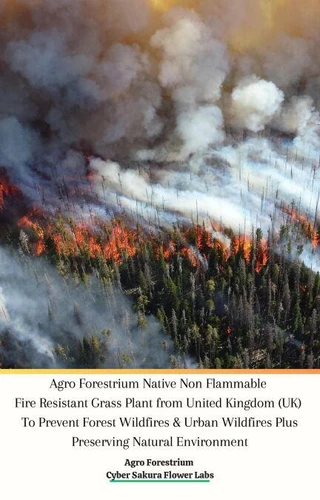Agro Forestrium Native Non Flammable Fire Resistant Grass Plant from United Kingdom (UK) To Prevent Forest Wildfires & Urban Wildfires Plus Preserving Natural Environment
Par : , ,Formats :
Disponible dans votre compte client Decitre ou Furet du Nord dès validation de votre commande. Le format ePub est :
- Compatible avec une lecture sur My Vivlio (smartphone, tablette, ordinateur)
- Compatible avec une lecture sur liseuses Vivlio
- Pour les liseuses autres que Vivlio, vous devez utiliser le logiciel Adobe Digital Edition. Non compatible avec la lecture sur les liseuses Kindle, Remarkable et Sony
 , qui est-ce ?
, qui est-ce ?Notre partenaire de plateforme de lecture numérique où vous retrouverez l'ensemble de vos ebooks gratuitement
Pour en savoir plus sur nos ebooks, consultez notre aide en ligne ici
- FormatePub
- ISBN8227913869
- EAN9798227913869
- Date de parution28/03/2025
- Protection num.pas de protection
- Infos supplémentairesepub
- ÉditeurBig Dog Books, LLC
Résumé
In the UK, native non-flammable and fire-resistant grass plants are specially adapted to local environmental conditions, making them highly effective in wildfire prevention and ecological protection. These grasses are native, meaning they naturally occur in the region and are well-suited to the local climate and soil. Their non-flammable property means they are less likely to ignite or sustain a fire, acting as a natural barrier that slows the spread of wildfires.
This is crucial in forest management, as it helps prevent wildfires from expanding and causing extensive damage. Additionally, these grasses contribute to ecological balance by supporting local biodiversity. They provide habitat and food for various wildlife and help maintain soil health by preventing erosion. Their presence can also reduce the amount of highly flammable vegetation that could otherwise fuel larger fires.
By incorporating these fire-resistant grasses into landscape management strategies, we can enhance forest resilience against fire, protect valuable ecosystems, and support conservation efforts. This approach not only helps in mitigating fire risks but also aids in maintaining the health and stability of natural habitats.
This is crucial in forest management, as it helps prevent wildfires from expanding and causing extensive damage. Additionally, these grasses contribute to ecological balance by supporting local biodiversity. They provide habitat and food for various wildlife and help maintain soil health by preventing erosion. Their presence can also reduce the amount of highly flammable vegetation that could otherwise fuel larger fires.
By incorporating these fire-resistant grasses into landscape management strategies, we can enhance forest resilience against fire, protect valuable ecosystems, and support conservation efforts. This approach not only helps in mitigating fire risks but also aids in maintaining the health and stability of natural habitats.
In the UK, native non-flammable and fire-resistant grass plants are specially adapted to local environmental conditions, making them highly effective in wildfire prevention and ecological protection. These grasses are native, meaning they naturally occur in the region and are well-suited to the local climate and soil. Their non-flammable property means they are less likely to ignite or sustain a fire, acting as a natural barrier that slows the spread of wildfires.
This is crucial in forest management, as it helps prevent wildfires from expanding and causing extensive damage. Additionally, these grasses contribute to ecological balance by supporting local biodiversity. They provide habitat and food for various wildlife and help maintain soil health by preventing erosion. Their presence can also reduce the amount of highly flammable vegetation that could otherwise fuel larger fires.
By incorporating these fire-resistant grasses into landscape management strategies, we can enhance forest resilience against fire, protect valuable ecosystems, and support conservation efforts. This approach not only helps in mitigating fire risks but also aids in maintaining the health and stability of natural habitats.
This is crucial in forest management, as it helps prevent wildfires from expanding and causing extensive damage. Additionally, these grasses contribute to ecological balance by supporting local biodiversity. They provide habitat and food for various wildlife and help maintain soil health by preventing erosion. Their presence can also reduce the amount of highly flammable vegetation that could otherwise fuel larger fires.
By incorporating these fire-resistant grasses into landscape management strategies, we can enhance forest resilience against fire, protect valuable ecosystems, and support conservation efforts. This approach not only helps in mitigating fire risks but also aids in maintaining the health and stability of natural habitats.





